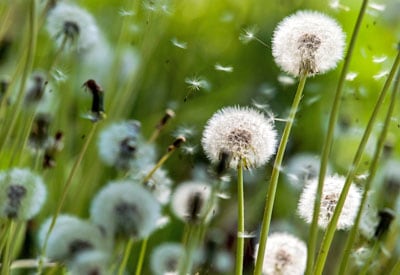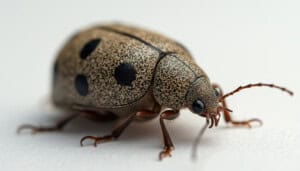Young children are filled with glee at the sight of the beautiful, bright yellow flowers that dandelions produce in early spring. Their heads then dry out, and parachute-like seeds form that look like fluffy seed heads. The wind, and sometimes kids, can then easily spread these seeds.
It’s a perennial weed, meaning it comes back each year and has characteristic fleshy taproots. These can be 6 to 18 inches long but can grow even deeper into the soil if it hasn’t been dealt with quickly enough.
Since dandelion seeds are spread by wind, no lawn or planting bed is safe from a dandelion seed invasion. Learning how to tackle these pesky weeds is a great skill every gardener should know more about.
This complete guide will teach you all of that and more, including how to get rid of them effectively and also stop them from reseeding once you’ve handled them.

#1 WEED KILLER
AllDown
A SAFE alternative to RoundUp® that's trusted by cities and municipalities.
Learn moreWhat are Dandelions?
Dandelions are a type of weed known as a broadleaf perennial, and they are known for being hard to get rid of if not addressed quickly.
It’s a type of perennial weed with a thick, vertically rising taproot. Its English name is derived from its French name, ‘dent de lion,’ which translates to lion’s tooth. It got its name from the highly serrated leaves that develop on the plant.
Once a dandelion plant has successfully established its 10-inch-long taproot, the weed will continue to return year after year and spread its spores throughout your lawn indefinitely. The solution to complete eradication lies in that long root.
If you want to get rid of dandelion for good, you must destroy or remove the entire taproot, or the undesirable sprout will return and become an even bigger problem to deal with.
How to Get Rid of Dandelions Effectively
Learning how to get rid of dandelions effectively is a great skill every gardener should have. Here are all the top ways you can get rid of them effectively in your yard:
Dig Them Up
Hand-pulling dandelions after digging them up is, by far, one of the most effective ways of getting rid of them.
To try this method, use a watering can to dampen the soil surrounding the dandelion, then wait a few minutes for the moisture to sink in. Moist soil makes it easier to pull any plant from the ground.
Next, make two or three cuts with a weeding knife along the dandelion’s base. Wiggle the knife to move the soil away from the plant’s root.
Finally, gently tug on the base of the plant with your fingers and pull it. In the event that it continues to feel as though it is stuck, work the weeding knife around it some more, and then carefully pull out the entire taproot together with the dandelion.
Use Acetic Acid
Once you’ve removed the root as deeply as you can you’ll be left with a small hole where the plant was removed. This is when you need some vinegar.
Unfortunately, household vinegar only contains 5% acetic acid making it not strong enough to kill these pesky weeds. Horticultural vinegar, on the other hand, is much stronger and commonly used as a weed killer.
But since it’s so strong, you need to be careful while using it and it’s highly recommended to wear gloves and other protective equipment to keep yourself safe.
If you have a lot of dandelions, this will take some time. Don’t make it too much work. Mark off a space and leave the rest for another day. This is a task you want to finish. If the dandelions are starting to flower — and this happens quickly in the spring — have your kids pick the blossoms before they can go to seed.
Use Boiling Water
Using boiling water is another incredibly easy way to get rid of dandelions. Water and an electric or stovetop kettle are all you need with this method.
Immediately after bringing the water to a boil, pour it over the dandelions’ leaves, making sure that enough water gets to the roots. You’ll see that the leaves have turned brown in two to four hours. Then you can pull the entire plant out, along with its taproot.
Flaming Dandelions
You can burn your dandelions too! The technical term for this method is ‘flaming.’ What you are really doing is essentially using a weed torch to kill your dandelions.
This technique is typically used to manage bunched patches of broadleaf weeds. Flaming is the practice of burning immature seedlings that are germinating in the ground by sweeping a hot propane torch over the area.
This method is less successful against fully grown dandelion plants with a well-established root system and works best on seedlings that are concentrated in particular areas.
It should be mentioned that this technique has a considerable danger due to the use of fire on grass. The process does have effects on things other than the weeds. For example, because it needs heat to kill the weeds, it can burn your grass.
Consider Reseeding
A tough but successful method of eliminating dandelions and stopping their regrowth is to lay down new grass seed or sod. Zoysia grass, Bermuda grass, tall fescue grass, and perennial ryegrass are all viable options, depending on where you live.
These varieties tend to create thick, dense lawns that naturally choke off weeds, but only if they are maintained regularly. Regular lawn care and, if necessary, reseeding once a year will keep the grass thick enough to keep dandelions and other weeds at bay.
Use Your Lawn Mower
A big part of dandelion prevention is taking out time for lawn care to have a healthy lawn. When you have dandelions in your yard, periodic mowing can help prevent their spread.
The white puffy seed heads won’t form if the yellow heads on the stem are cut off, which will stop the spread of more dandelions in your yard. If you mow your lawn now, you’ll have to deal with weeds less next year.
Try a Pre-Emergent
In order to stop weeds from sprouting in your lawn or flowerbed, you can use a chemical called a pre-emergent. For a pre-emergent to be effective against dandelions, it needs to be applied in late winter.
The pre-emergent will stop the dandelion seeds from growing, but it will only work if it is applied before the seeds have a chance to grow and germinate.
Among all the methods for dandelion control, the most important thing to remember is that you must prevent weeds from producing seeds.
As soon as the seed heads appear, the number of dandelions in your yard and your surroundings will surge.

How to Kill Dandelions with Herbicides
Another method you can use that we felt deserved its own section is herbicides. You can use them to carefully target and kill the dandelion root.
Herbicides come in two main types that can be used on dandelions. The first is a selective broadleaf herbicide. Broadleaf herbicides are only effective against broadleaf weeds, such as dandelions. They are good for getting rid of dandelions in lawns because they only kill the weeds and not the grass.
There is also the option of using a non-selective herbicide, which is also effective against dandelion. Since it’s non-selective, this means it will damage and kill any plant with which it comes into contact. Nonselective herbicides are helpful for spot dandelion removal, such as in flower beds and pathways.
When trying to get rid of dandelion with a herbicide, it is always best to use the herbicide before the dandelion flowers. Once dandelion flowers have bloomed, the plant is significantly more resistant to herbicides, and broadleaf or non-selective herbicides are less effective.
The fall is the best time to spray dandelions because this is the time of year when plants are naturally moving nutrients from their leaves to their roots in preparation for the upcoming winter in the form of winter storage.
Applying weed killer in the fall allows it to travel directly to the roots, which assists in getting rid of dandelions for good.
However, always remember not to use any lawn feed products to kill dandelions in the fall, though, because your lawn won’t be able to use the fertilizer if it goes dormant for the winter. Instead, any weeds that are present absorb the fertilizer and grow stronger as a result.

A BESTSELLER!
Organic Weed & Feed
Use to prevent crabgrass, dandelions and more! Pelleted for easy application.
$14.95Learn moreHow to Keep Dandelions From Reseeding Once Removed?
Unfortunately, as we’ve learned till now, dandelion seeds can travel far with the wind or when kids play with their fluffy seed heads.
To discourage them from reseeding once you’ve removed them, spread some corn gluten on your garden. It will stop any broadleaf seed that comes into contact with it from germinating.
Mulches made of maple and ash leaves are also known to act as a natural deterrent against the emergence of dandelion flowers in the spring. Like any mulch, though, you don’t want to use so much that your grass dies.
Again, if you don’t want dandelions to grow in your yard, the key is to have healthy soil. The denser and lusher your grass grows, the less opportunity there is for weeds like dandelions from taking root in it.
Benefits of Dandelions in Your Yard
As you can see, diligence and a good work ethic are required to deal with dandelions effectively. There’s one other quality that can help: tolerance.
As home gardeners, we learn over time to sometimes tolerate some insects in our gardens (especially the beneficial ones) and a few weeds poking up through the mulch (until they compete with our plants for moisture).
In the same way, tolerating dandelions will save you a lot of the work they require, especially when you have large areas of lawn or fields. After all, they can be attractive depending on your point of view.
In addition, bees and other pollinators rely heavily on the nectar and pollen that can be found in dandelion flowers. So, getting rid of too many of these nectar-rich flowers can hurt the environment in the long run.
In spite of the fact that the vast majority of people think of it as an invasive and unattractive weed, it is in fact a plant that possesses therapeutic properties, such as the ability to be used as a laxative and a diuretic. Greens from dandelion plants are sometimes used in salads and other dishes that are inspired by gardens.
Regardless of whether you decide to leave some around, or make sure to get rid of them entirely, this article has everything you’ll ever need to tackle dandelions in your yard effectively.











